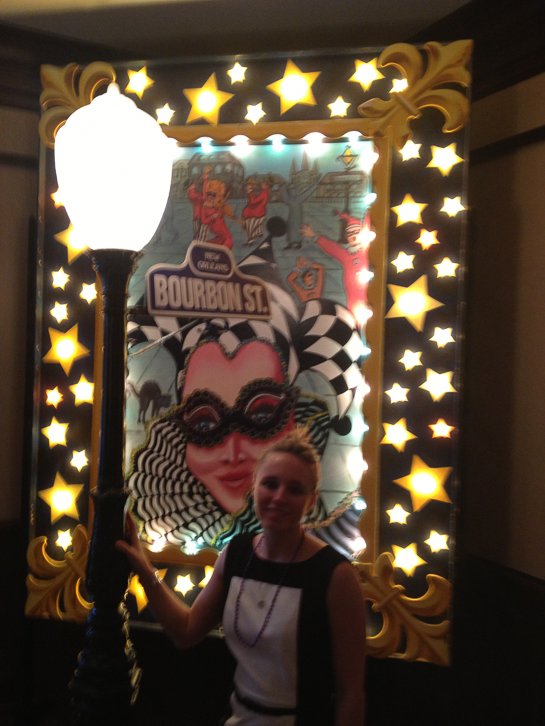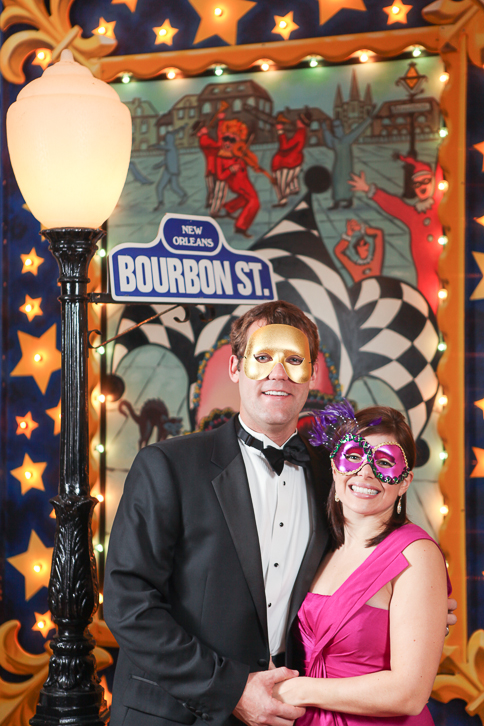Thank you iPhone for providing me with job security. Please continue to manufacture camera phones with more and more megapixels!
Recently, while documenting a Mardi Gras-themed gala, I stumbled upon the amazing backdrop below (busy, I know, but have you ever been to Bourbon Street?). Dozens of attendees photographed this elaborate scene with their camera phones. Invariably they told me “My photos don’t look like yours”. A fundraiser at the most exclusive private club in the city isn’t really the place to explain the merits of a DSLR vs an iPhone camera, however this blog certainly is. The number of megapixels (8 in the case of an iPhone 4) provides a common language to compare DSLR cameras to cell phones. However, that is the only comparable attribute between the two devices.
When purchasing a camera, the number of megapixels is the last item that I am concerned with (well, maybe smell is the last, but megapixels is a close second. Useful tidbit – photos taken with a 6 megapixel camera can be blown up to 20″ X 30″ and larger without pixelating). For me, type of focus, number of focal points, ergonomics, ISO, sensor size and type, noise, low light focus, menu layout, and several attributes take precedence over ‘how many megapixels’ when considering a camera body.
Let’s take a gargantuan leap of faith and pretend for a moment that an iPhone does in fact house all of the aforementioned features of a real camera (note, now we’re approaching what Rodney Dangerfield referred to as “Fantasy Land” as the laws of physics, and more specifically optics, currently preclude this from becoming a reality… I don’t care how innovative the folks in Cuppertino are). Now we have reduced the difference between shooting an event with the iPhone and a DSLR to a function of lighting. Sorry to disappoint, but while its become more and more prevalent for cell phone cameras to emit a flash, this magnificent tease is probably even less effective than the onboard flash that most cameras are equipped with (if that’s even possible). Great for a grainy snapshot of someone hitting your quarter panel at midnight and for uploading the 500 photos of your Miniature Poodle Precious you’ve taken in the past 48 hours to your blog (look how adorable Precious is on his left side, now look at how cute his is on his right side. Don’t you think my Precious is just, just precious?!) and that’s about it.
In brief, until Apple, Motorola, etc figure out a way to calibrate white balance; provide adjustable depth of field (not that cheesy ‘blur’ slider on picasa, etc); eliminate noise; control shutter speeds; remedy optical compression and distortion; create and control the light intensity, falloff and ratios; allow for spot metering and matrix metering; manipulate the spill, diffusion and direction of the light emitting from multiple light sources simultaneously all of which are oftentimes positioned asymmetrically, somewhat askew and at varying distances from both the camera phone and the subject; and provide a means of separation from the subject and its background, its safe to say I’ll have a job. That is, unless one prefer’s the classic “coal miner standing 3 feet from me beaming me with his headlamp” look. Its a cool, edgy look that gives me a warm, fuzzy feeling. Similar to that feeling you get every time someone shines a harsh, concentrated beam of light in you face while shouting the phrase “Driver, keep both hands on your steering wheel where I can see ’em!”
You Be The Judge – when sponsors are spending $3000 – $5000 per table at a fundraising event trying to generate six figures in donations at the most exclusive private club in town, which photo would they prefer their clients walk away with / send out to their friends / use for their marketing publications (Pardon the left photo’s framing, blur, backlighting, false color temperature, etc. It was taken with an iPhone:).


